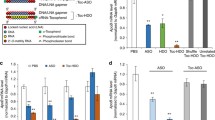Abstract
Apoptosis is a genetically controlled mechanism of cell death which is important for embryogenesis, metamorphosis, tissue homeostasis and tumor regression of multicellular organisms. In normal cells as well as in transformed cells signals released from the cytoplasm and/or the cell membrane can trigger the activation of caspases which in turn cleave many cellular substrates, leading to the characteristic morphology of apoptosis.
Systematic analysis and dissection of apoptotic pathways was obtained by the use of knock out or transgenic organisms, expressing dominant active or negative proteins.
The use of antisense oligonucleotides (ASO) for analysis of apoptotic pathways was commonly restricted to cultured cells, because of the low efficacy of ASO in in vivo experiments. In order to investigate the contribution of specific apoptotic pathways in the onset and maintenance of disease in vivo experiments are needed. This approach allows the analysis of apoptotic pathways within their physiological/pathophysiological environment. The combination of recent advances in in vivo gene delivery with siRNA technique for efficient gene silencing provides new, unique possibilities to study apoptotic pathways thereby evaluating new molecular therapeutic strategies in vivo.
In this minireview we will focus on the use of RNA interference for analytical and therapeutical suppression of apoptotic pathways in vivo with special consideration of the liver.
Similar content being viewed by others
References
Hannon GJ. Nature 2002; 418: 244–251.
Bernstein E, Denli AM, Hannon GJ. RNA 2001; 7: 1509–1521.
Hammond SM, Bernstein E, Beach D, Hannon GJ. Nature 2000; 404: 293–296.
Paddison PJ, Caudy AA, Bernstein E, Hannon GJ, Conklin DS. Genes Dev 2002; 16: 948–958.
Bridge AJ, Pebernard S, Ducraux A, Nicoulaz AL, Iggo R. Nat Genet 2003; 34: 263–264.
Lassus P, Opitz-Araya X, Lazebnik Y. Science 2002; 297: 1352–1354.
Wurzer WJ, Planz O, Ehrhardt C, et al. EMBO J. 2003; 22: 2717–2728.
Chun HJ, Zheng L, Ahmad M, et al. Nature 2002; 419: 395–399.
Zender L, Hutker S, Liedtke C, et al. Proc Natl Acad Sci USA 2003; 100: 7797–7802.
Song E, Lee SK, Wang J, et al. Nat Med 2003.
Braasch DA, Corey DR. Biochemistry 2002; 41: 4503–4510.
Jansen B, Wacheck V, Heere-Ress E, et al. Lancet 2000; 356: 1728–1733.
Bertrand JR, Pottier M, Vekris A, Opolon P, Maksimenko A, Malvy C. Biochem Biophys Res Commun 2002; 296: 1000–1004.
Kretschmer-Kazemi FR, Sczakiel G. Nucleic Acids Res 2003; 31: 4417–4424.
Grunweller A, Wyszko E, Bieber B, Jahnel R, Erdmann VA, Kurreck J. Nucleic Acids Res 2003; 31: 3185–3193.
Miyagishi M, Hayashi M, Taira K. Antisense Nucleic Acid Drug Dev 2003; 13: 1–7.
Danko I, Williams P, Herweijer H, Zhang G, et al. Hum Mol Genet 1997; 6: 1435–1443.
Budker V, Zhang G, Knechtle S, Wolff JA. Gene Ther 1996; 3: 593–598.
Zhang G, Budker V, Wolff JA. Hum Gene Ther 1999; 10: 1735–1737.
Maruyama H, Higuchi N, Nishikawa Y, et al. J Gene Med 2002; 4: 333–341.
Hartikka J, Sukhu L, Buchner C, et al. Mol Ther 2001; 4: 407–415.
Somiari S, Glasspool-Malone J, Drabick JJ, et al. Mol Ther 2000; 2: 178–187.
McCaffrey AP, Meuse L, Pham TT, Conklin DS, Hannon GJ, Kay MA. Nature 2002; 418: 38–39.
Lewis DL, Hagstrom JE, Loomis AG, Wolff JA, Herweijer H. Nat Genet 2002; 32: 107–108.
Hemann MT, Fridman JS, Zilfou JT, et al. Nat Genet 2003; 33: 396–400.
Galle PR, Hofmann WJ, Walczak H, et al. J Exp Med 1995; 182: 1223–1230.
Strand S, Hofmann WJ, Grambihler A, et al. Nat Med 1998; 4: 588–593.
Streetz K, Leifeld L, Grundmann D, et al. Gastroenterology 2000; 119: 446–460.
Kuhnel F, Zender L, Paul Y, et al. J Biol Chem 2000; 275: 6421–6427.
Mundt B, Kuhnel F, Zender L, et al. FASEB J 2003; 17: 94–96.
O'Grady JG, Schalm SW, Williams R. Lancet 1993; 342: 273–275.
Plevris JN, Schina M, Hayes PC. Aliment Pharmacol Ther 1998; 12: 405–418.
Kubicka S, Kuhnel F, Zender L, et al. J Biol Chem 1999; 274: 32137–32144.
Feng G, Kaplowitz N. J Clin Invest 2000; 105: 329–339.
Zhang H, Cook J, Nickel J, et al. Nat Biotechnol 2000; 18: 862–867.
Sorensen DR, Leirdal M, Sioud M. J Mol Biol 2003; 327: 761–766.
Martinez LA, Naguibneva I, Lehrmann H, et al. Proc Natl Acad Sci USA 2002; 99: 14849–14854.
Jiang M, Milner J. Genes Dev 2003; 17: 832–837.
Author information
Authors and Affiliations
Corresponding author
Rights and permissions
About this article
Cite this article
Zender, L., Kubicka, S. SiRNA based strategies for inhibition of apoptotic pathways in vivo—analytical and therapeutic implications. Apoptosis 9, 51–54 (2004). https://doi.org/10.1023/B:APPT.0000012121.52210.23
Issue Date:
DOI: https://doi.org/10.1023/B:APPT.0000012121.52210.23




